This is the Introduction to a series of essays about cowkeepers in London in the 17thC and 18thC. Thanks to online access to contemporary newspapers and scholarly publications I found many primary sources, some of which I include in the text and others - much longer - which I offer as separate drill-down transcripts.
Links to all the essays and extracts are offered on the Cowkeepers' home page. Links to the sections of this essay are in the left-hand margin here.
Setting the scene
When my grandmother Hannah was born in 1873, her father was an iron turner in Bradford, in the West Riding of Yorkshire. By the time of the 1881 census he was a milk dealer. His father had a grocery shop and no doubt suggested this career change, so Samuel WOOD had found himself an out-of-town dairy farmer, and was bringing milk into town by train.
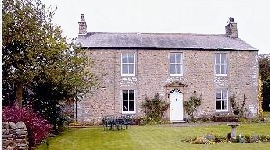
The out-of-town dairy farmer, Isaac WINTER, would become my other great-grandfather. He had moved his herd, his young family and his second wife from the high Pennine district of Stainmore to Otterburn Hall in the gentler southern dales. This was conveniently close to Bell Busk station on the busy railway line that ran from Ingleton to Skipton, and from there into the cities of Bradford and Leeds. I write about these family ancestors separately, but I mention them here because they are one of the reasons why I decided to investigate urban milk supply. In the mid 1800s, the growth of the mill-towns and factories meant that many more people were living in urban streets instead of villages and fresh milk had somehow to be brought to them, instead of them popping along the lane with an empty jug.
I had already come across cow-keepers when researching the late 19thC migration from the Yorkshire dales, where the destination ‘West Derby’ kept cropping up. West Derby is now a district of Liverpool but then it was two quite separate things: a small village inland from Liverpool, and the much older name for the whole of south Lancashire. I did plan to investigate this later, and find out how true was the claim that there was a cow-keeper at the end of every Liverpool street, but another researcher connected to the Upper Dales Family History Group wanted to do it so I passed my notes on, leaving a back burner free for the next idea.
This 1825 painting by George Scharf [at the British Museum] is on the Sainsbury museum’s website and elsewhere on-line. A Guardian journalist has placed this cow-keeper in Golden Lane in the City of London, two blocks north of St Paul’s Cathedral, so that's good enough for me. The shop is apparently the ground floor of his house (but even HRH Prince Philip has joked about having to live ‘over the shop’). You can see the cows in their well-ventilated stalls at the back, a customer at the side window, and a lad pulling hay feed down into the cellar store.
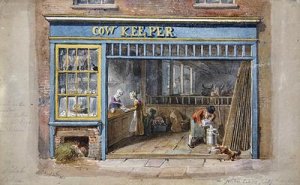 As well as a picture of a healthy-looking cow, the window display contains what looks like a plate of cheese, and a shelf of glass pots and jars – maybe advertising the sale of honey or jam from the home farm, or tea, or boiled sweets. Sugar in any form was becoming very popular and between 1700 and 1800 the amount imported from the new plantations in the West Indies increased more than ten times - from 23,000 tons to 245,000 tons, much of which went into tea, along with the milk. [Walvin]. The cowman is topping up the churn with milk and a scruffy dog is licking up the spills. I am not sure about the stack of planks – maybe it folded out into a screen to give security when the shop was closed – an old-fashioned version of the up-and-over grill used by modern shops.
As well as a picture of a healthy-looking cow, the window display contains what looks like a plate of cheese, and a shelf of glass pots and jars – maybe advertising the sale of honey or jam from the home farm, or tea, or boiled sweets. Sugar in any form was becoming very popular and between 1700 and 1800 the amount imported from the new plantations in the West Indies increased more than ten times - from 23,000 tons to 245,000 tons, much of which went into tea, along with the milk. [Walvin]. The cowman is topping up the churn with milk and a scruffy dog is licking up the spills. I am not sure about the stack of planks – maybe it folded out into a screen to give security when the shop was closed – an old-fashioned version of the up-and-over grill used by modern shops.
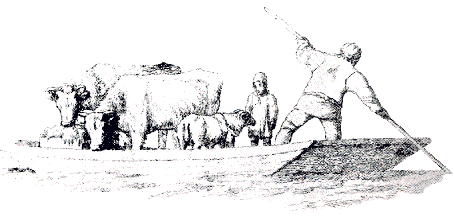
To find out more about these town-based dairies I turned first to Google books and then to the 18thC newspapers on the Gale website. I searched for ‘cow-keeper’ and quickly realised that the word itself had different meanings, depending on the century.
What was a cowkeeper?
In 19thC Liverpool he (sometimes she) was the urban dairy-man with a small herd, often in a cowshed in the back yard. He might have a milk delivery round but often customers came to him. Replacement cows arrived regularly, often from the cow-keeper’s family farming up in the Dales. This sketch from The Clothes of the Cut shows cows being moved by barge in the flatter countryside of the Midlands.
One of the many Metcalfe cousins of my dairy-farming great-grandfather was a cow-keeper in urban West Derby in the 1870s. But in the 18th century a cow-keeper was a dairy farmer with fields on the outskirts of the big cities. His herds were usually much larger and the milk was collected and distributed daily by several milk traders who contracted to buy the output of a proportion of the herd. The scope for cheating and adulteration was huge, as was the scope for making a respectable fortune, given a good cowman and a large herd.
Most growing cities had similar milk supply systems in place, but the earliest available newspaper reports are about London, and the first mention of cow-keeper was in 1681, when the Observator in Dialogue mentioned a satirical tract concerning “Roger Hodgkins, Button-Seller; Giles Pritchard, Cow-keeper; with other of their Associate-Princes...” which suggests that the cow-keeper was already so well established that everyone would understand the joke.
These newspapers were also a prime source for auction advertisements. Occasionally the sales were caused by retirement, but more often they were forced by bankruptcy. In my transcripts from the 1700-1800 newspapers I have the names of 208 different cowkeepers, plus another 52 described simply as ‘cow-keeper’ (for family historians, the list is here). Of these 260 people, fifty became bankrupt during that 100 years and eighteen died rich. Some of the bankrupts lost their houses and as many as 100 cows, whilst others failed on a smaller scale. The advertisements in the newspapers provided fascinating material that I have used in my other cowkeeper essays..
The early 18thC was what Richards and Quick (Britain 1714-1851) describe as ‘the golden age of the landed aristocracy’, with many stately homes being built, as well as huge town houses for the London season. Much of the land in London was already owned by these gentry and their names – Bedford, Berkeley, Cavendish, Devonshire, Grosvenor, Sloane and the rest – live on in the secluded squares of Mayfair and the West End.
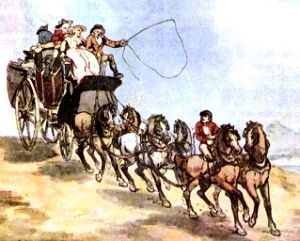
The atrocious cross-country roads meant that even post coaches could not manage more than three or four miles an hour, and the journey from London to Edinburgh took six days. On a journey from Chester to London in 1752:
"The roads were almost impassable. Sometimes we were buried up to our horses’ bellies, and at others we rode on such dangerous precipices as had almost endangered our falling." [M D George]
Large areas of the countryside were waste and the mediaeval strip farming of common land was still carried on. Livestock for the London markets walked long distances - drovers' roads travelled the high ground across many counties but the animals still had to arrive before October or risk getting stuck in the mud. Heavy and bulky goods were by now being moved on barges, by river and canal.
The health of the citizens
Health care was improving. In London the hospitals of Guy’s, Westminster, St George’s, London and Middlesex were all built between 1720 and 1745. But effective anaesthetics were still 100 years away and consumption, smallpox, dysentery, and typhoid kept the population down. Only one in four children born in London lived to the age of five. The poor sold their teeth for transplanting into the jaws of the rich. Broken or crushed limbs were common, infected wounds festered, milk-maids were gored and many cow-keepers’ lads died under the wheels of their heavy carts.
Those who could afford to drink wine and port regularly were not safe. Here is Stephanie Pain, writing 'Mr Handel is indisposed' in the New Scientist of 4th April 2009, explaining how lead poisoning and consequent ill health forced him to abandon his energetic program of large-scale operas and turn to smaller-scale, less physically demanding choral work.
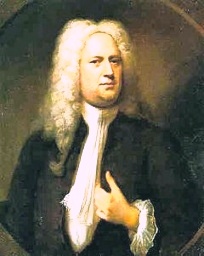
why Handel wrote "The Messiah"
One of his symptoms was saturnine gout, already known to affect plumbers, miners and pot-menders.
"Lead contaminated food, medicines, cosmetics, even the powder so liberally applied to the wigs then in fashion. But wine was the worst of all. Most wine was imported from southern Europe, where many makers added lead to sweeten it and prevent it going off en route to England. Once there, unscrupulous merchants added lead shot to freshen tired tasting wine and mask off flavours. Port was even more dangerous: it was fortified with brandy made in stills with lead parts and pipes."
She comments that many people have written about Handel’s notorious ill health and gluttony, especially his heavy drinking. He was known to invite friends to a meagre dinner then go off and binge in the pantry during the meal. She writes:
"Ingestion of 2 milligrams of lead a day can produce symptoms of severe lead poisoning within a year. An analysis of late 18thC port carried out in the 1970s found as much as 2 milligrams per litre. Handel may have been partial to burgundy, but port was his favourite tipple and he quaffed it in large quantities. ... In 1737 he suffered the first of a series of seizures that temporarily paralysed his right hand and caused his head to be ‘a good deal disordered’ ... In 1743 he had a second attack. In 1751 he lost the sight in his right eye. Two years later he was blind. He died in 1759 at the age of 74."
The London Evening Post of Thursday 12th May 1737 carried the following report:

It is ironic that without this indisposition Handel would not have had to reduce his workload and we would not have had The Messiah.
18th century London
Waggons thumped along uneven streets; porters dragged heavy articles along on sleds with iron runners, sellers of eggs, chickens, rabbits, oysters, fish, gingerbread, tripe, fruit, milk, thronged the streets and bawled their cries at the top of their voices all day long. Itinerant knife grinders, old clothes dealers, chair menders, chimney sweeps, rattled and pushed their way through the crowds. Strangers were advised to carry a stout stick and not go out at night into the unlit streets, although a torch-carrying link boy could be hired to light the way – sometimes through a lonely alley, when the boy put out his torch and his footpad friends plundered their victim.
18thC muggers
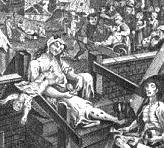
Drunken Hooray Henries were not a 20thC invention – the Mohock gangs were an early 18thC equivalent, out after a night’s heavy drinking to insult and fight any passerby. Drunkenness in all classes was common, and accepted – ‘drunk for a penny, dead drunk for tuppence, straw for free’ was the gin-shop's slogan in the appalled Hogarth’s 1750 engraving of St Giles’ parish. Foot-racing for prizes, and an early kind of cricket, were popular street games with both young men and young women; gamblers crowded round cock-fighting and bear-baiting; thousands watched bare-fist prize fights; life was noisy and brutal.
The scurrilous and abusive pamphlets of the 17thC had been taxed almost out of existence, largely replaced by well-edited multi-page newspapers worth subscribing to despite the 1712 tax (a penny per sheet, plus 12d for each advertisement). The first daily news-sheet was the Daily Courant (1702). Until the 19thC, most provincial newspapers copied from the London press and just added a few local stories. One famously printed “there was no news today” on a blank sheet. A young Samuel Johnson wrote an anonymous political column, although sometimes Parliament was so boring, he said later, that he stayed home and invented the debates [Finnemore].
Londoner artisans were doing very well, compared with their European neighbours. In 1717, Lawrence Braddon calculated the amount of land required to support what he defined as the present living standards of a notional 100,000 men, women and children in France, Spain, Ireland and Scotland. [M D George] Here are his conclusions, in his own tactless words:
| Country | acres | Acreage required to feed 10,000 - observed present requirements |
| France | 35,000 | chestnuts and water for meat and drink, cloth’d in coarse canvas and wooden shoes |
| Ireland | 50,000 | potatoes and sour milk, but land to be managed with more art and industry than those lazy Irish generally practise |
| Scotland | 70,000 | oatmeal and water and coarse plaid |
| Spain | 100,000 | Salleting, onions and garlic, very little flesh but the best bread in Europe, wearing coarse bays, long tilters [rapiers] and patch’d clothes; but land to be managed with much more art and industry than those lazy Spaniards are generally guilty of |
However, Braddon decided that 250,000 acres would be required to support 100,000 ‘sober, ingenious and industrious’ Londoners, since they expected to eat:
"good white or wheaten bread, good beef, veal, mutton, lamb, pork, pig and fowl of all sorts, and good pudding; and eat good fish, both salt and fresh, and fruits and herbs of all kinds in their seasons; and drink good beer, and sometimes wine, cyder, and English brandy; and wear good linen and woollen of all sorts; good hats, gloves, stockings and shoes".
I am not sure that Braddon was comparing like with like (his Spaniards sound more like soldiers than artisans). He was a Whig barrister and a great campaigner in favour of the poor being able to support themselves with dignity, and wrote copiously on this subject. Elsewhere on this website, in his essay on the price of bread, John has used another set of comparative data which supports this English obsession with meat-eating. He also gives information about wages and bread prices in the 18thC, which sits nicely with this essay - we do talk to each other quite often.
Here is a map of London in about 1746 (re-drawn by John). I have written elsewhere about how the rivers were used as sewers and consequently I have not coloured the Thames blue.
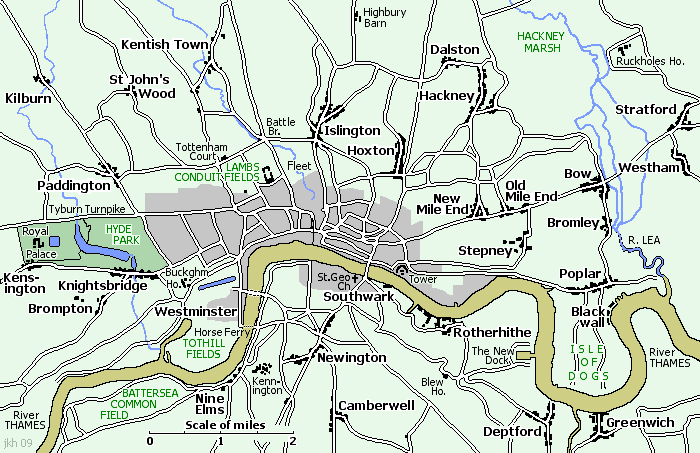
The villages of Paddington and Poplar
For anyone who knows modern London, the tiny size is astonishing. Places which are now embedded in the metropolis were then quite separate – Kensington, Paddington, Islington, Mile End, Poplar – were all little hamlets or villages. Hyde Park and Kensington Gardens were royal parks, not the lunch-time picnic site for hundreds of nearby office workers. Although the slum City parish of St Giles Cripplegate had a population of possibly 40,000 in 1700 [Luu], only a mile away a Mrs Cornely’s elegant furnished house in Soho Square sold for £10,200 in 1772, which was a huge sum but confirms that there was occasionally a lot of money about.
The map shows that the separate Cities of London and Westminster are joined by the building and development of the West End, which started after the restoration of the monarchy in 1660. Most of the land south of the river was marshy and undrained and, apart from Southwark and the Borough, only the river-side itself was built up. But the marshy ground was good enough for cows and the common land called St George’s Fields at Southwark was the centre for the south-of-the-river cowkeepers. The problem of draining these fields was of great interest and, when a major draining project started in Lincolnshire in the 1720s, it was reported widely and at length in the London newspapers.
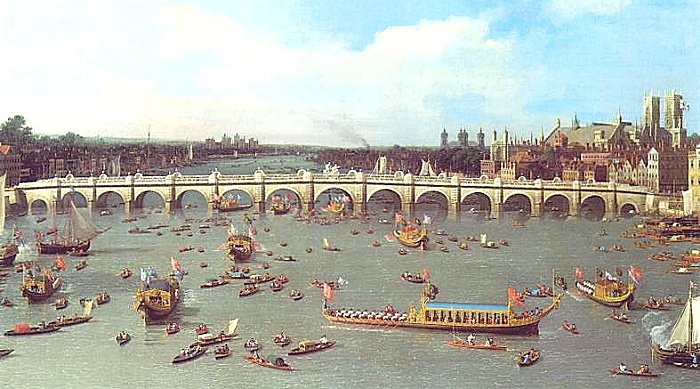
This wonderful painting of the newly-built Westminster Bridge [on Wikipedia and elsewhere] was made by Canaletto in 1746. Up ahead, around the corner, was the old London Bridge but the demands of tall masts in the busy Pool of London meant that no other bridge could be built past there until the elevating Tower bridge was built in 1894 (you can just see the Tower of London on the skyline). The Thames is still tidal at Westminster and twice a day the stinking muddy banks would be exposed. London was a smelly place, although Wordsworth had a less realistic response when he stood on Westminster bridge early one September morning in 1802:
Earth has not anything to show more fair:
Dull would he be of soul who could pass by
A sight so touching in its majesty:
This City now doth, like a garment, wear
The beauty of the morning; silent, bare,
Ships, towers, domes, theatres, and temples lie
Open unto the fields, and to the sky;
All bright and glittering in the smokeless air.
Never did sun more beautifully steep
In his first splendour, valley, rock, or hill;
Ne'er saw I, never felt, a calm so deep!
The river glideth at his own sweet will:
Dear God! the very houses seem asleep;
And all that mighty heart is lying still!
the river Thames was the main highway
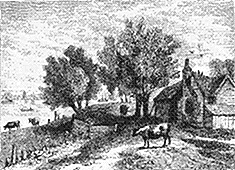
As well as the fixed bridges there were ferries, the main one being the Horse ferry from Westminster's Millbank across to the fields of Lambeth. There were also the watermen, whose guild objections had successfully delayed the building of Westminster bridge for many years.
These little river taxis scuttled along and across the river, moving people and goods – and probably the occasional cow and churn of milk and certainly the occasional drowned body - between the flights of stairs or jetties which dotted both sides of the river banks, as you can see in Canaletto's painting.
From fifty years later, British History Online has this engraving of the river bank at Millbank, the river end of the Horseferry Road, in about 1800. Today this cow-patted track is an elevated dual carriageway and the cows are long gone.
Newspaper reports
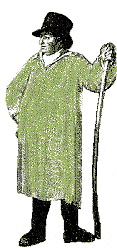
The illustrated magazine London Society in 1862 published a short humorous story about the dog of John Boodle, cowkeeper of Drury Lane. What is interesting is that the cowkeeper is described in detail and written in dialect [I think it is supposed to be Scots]:
"Ye maun; ye maun see me. I’m here and my name’s John Boodle, cowkeeper, of Drury Lane; and I understand as how you know all aboot the stealing of my dog; and I’ll have you oop as a witness."
The story goes on -
"John Boodle was a terrible-looking personage in my dainty little snuggery. I dare say he would have looked very picturesque, and all that sort of thing, out in a field, or in a cow-shed, but John Boodle with a huge, glazed hat on his head, his high-lowed feet emulating the proportions of an elephants, and arrayed as to his middle man in a green smock-frock which emitted an atmosphere of cows in a sort of vaccine sirocco, which pervaded the whole room in a moment, was an object of unpleasant portent. And his terrible aspect was further aggravated by his hands, which were so large and red and plump, that you might have imagined them to be boxing-gloves of flesh and blood ; and by his eyes, which were not on a line and were disproportionate as to the amount of white they exhibited."
London was still quite a small place. The newspapers carried news from the whole city and if you could read then you would probably already know something of the people being written about. My set of notes and transcripts from the Burney Collection is 53 pages long and contains the names of hundreds of people, so I can only give highlights in this essay. There were footpads and haystack fires (valued at many hundreds of pounds) and daft races and lottery wins and many stolen horses and burglaries and marriages. Here are links to the more ephemeral and personal stories I found in the newspapers:
- Illustrations of the times - a runaway, a whipping, a horse race to St Alban's and back, an amorous bricklayer, a discreet abortionist, Mr Pitt's capacity for port, and more;
- The state lottery, and the huge prizes to be won;
- Death notices for wealthy, and not-so-wealthy, cow-keepers;
- The life and business of Christopher Capper, who died worth £30,000; and the story of the hard-working Benjamin Coker, are in the essay called Living in Style.

